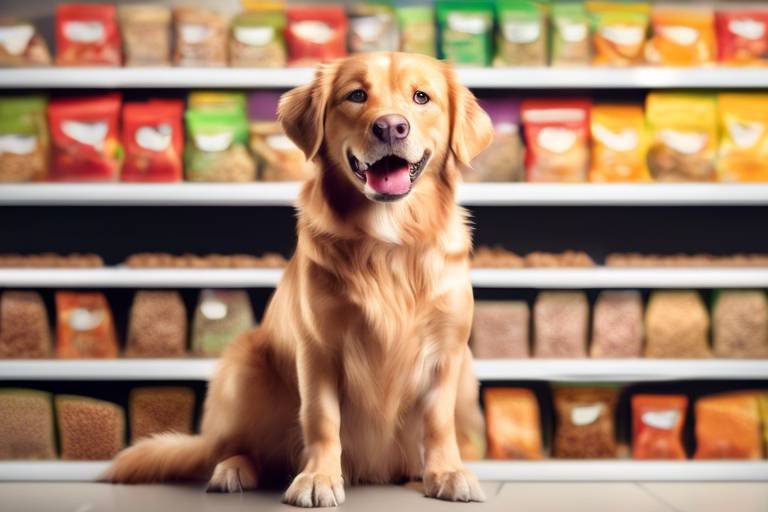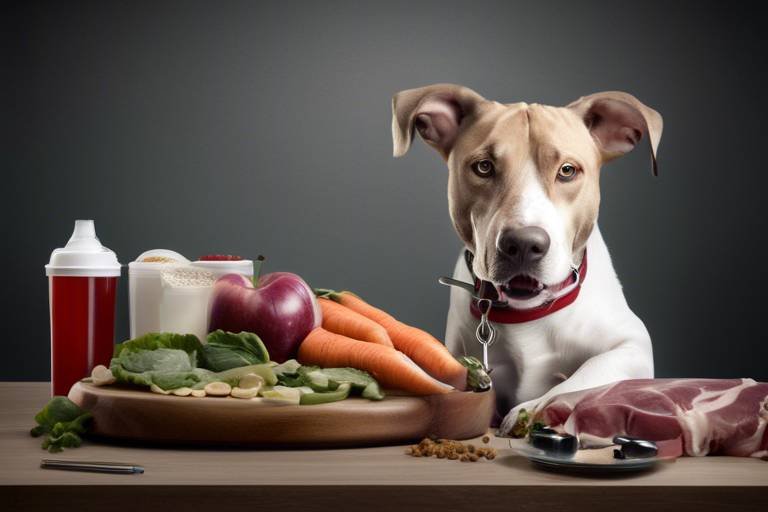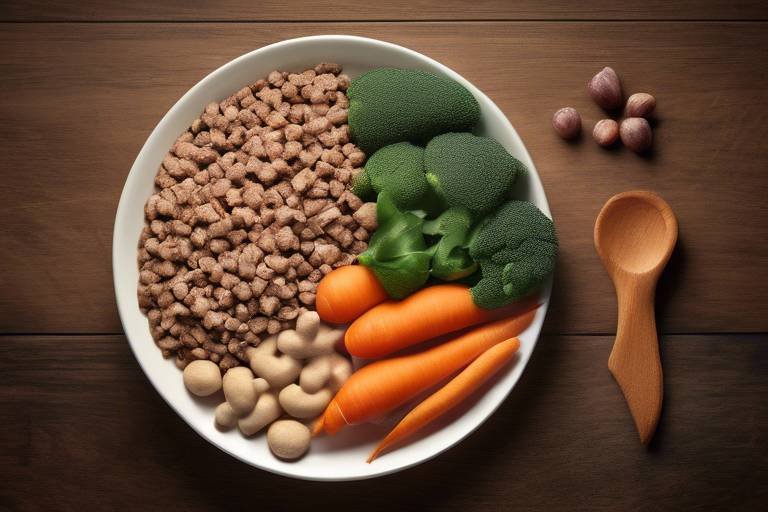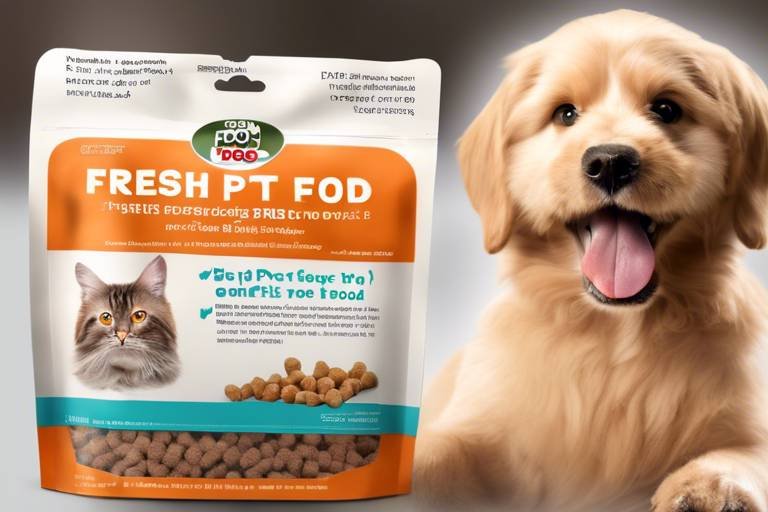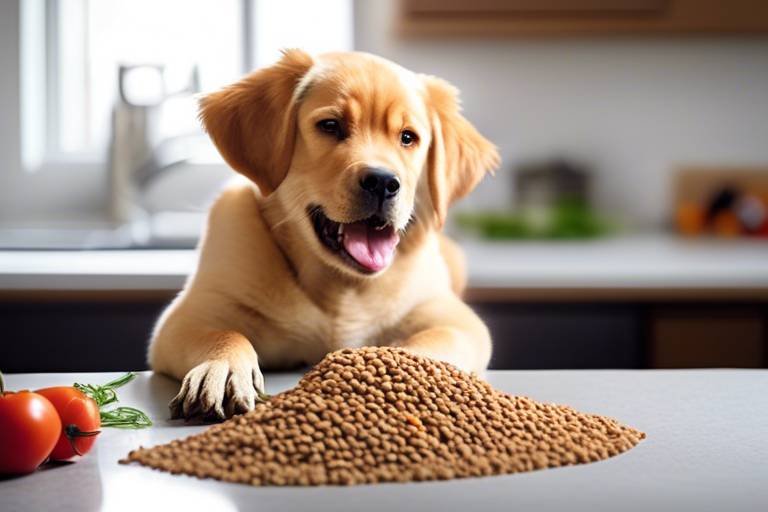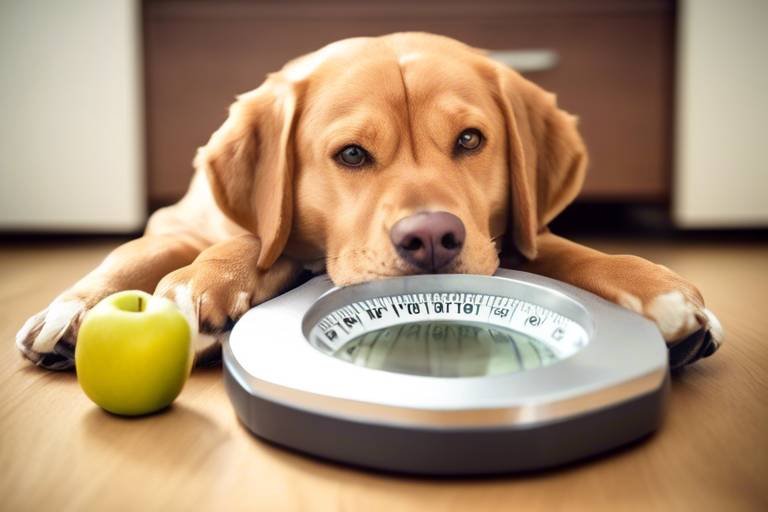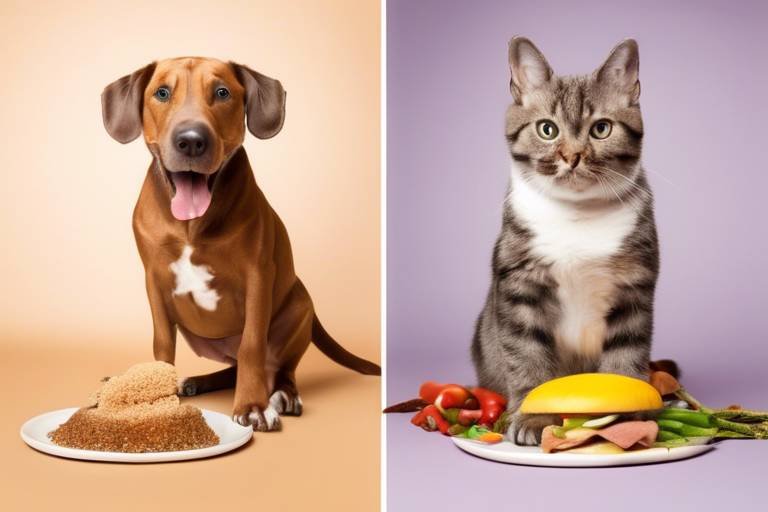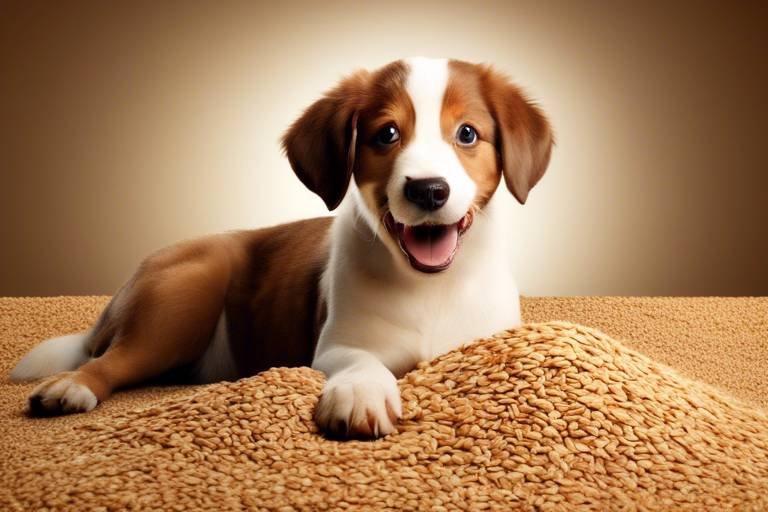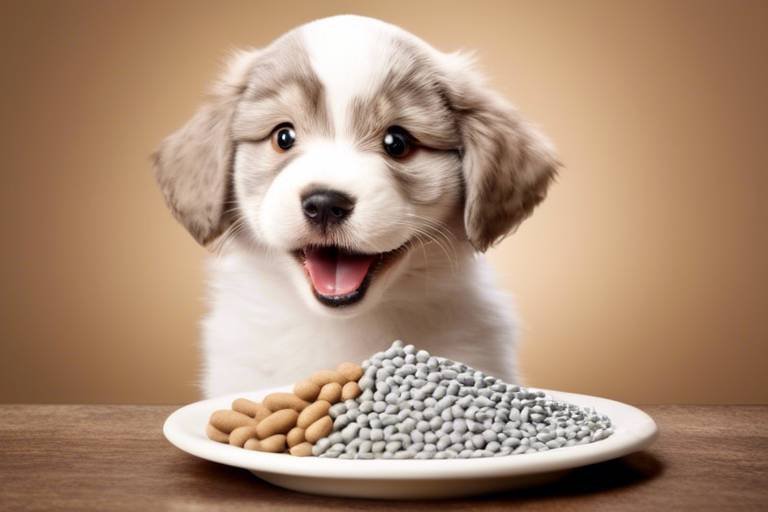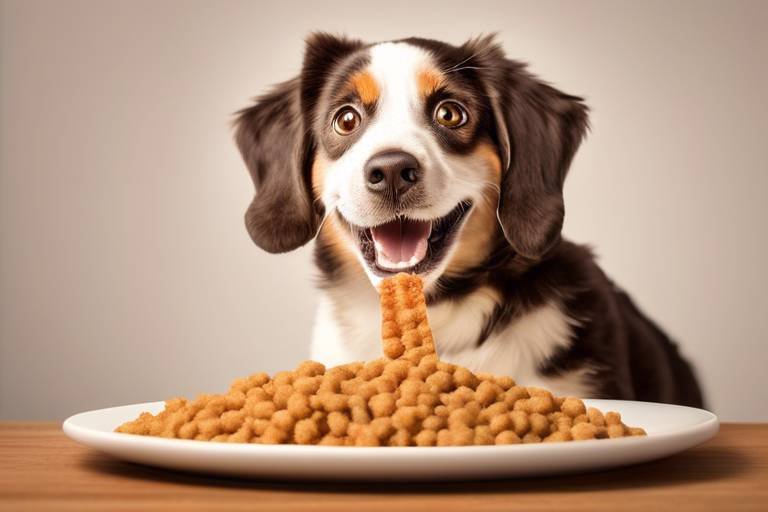How to Make Healthy Choices When Buying Pet Food
When it comes to our furry companions, making healthy choices in pet food is paramount. After all, what we feed them directly influences their overall health, energy levels, and longevity. But with the plethora of options available in stores and online, how do we ensure that we’re selecting the best food for our beloved pets? This article dives into the essentials of pet nutrition, the intricacies of reading pet food labels, and the various types of food available, all aimed at helping you make informed decisions that will keep your furry friends happy and thriving.
First things first: understanding pet nutrition is crucial. Just like humans, pets require a balanced diet to maintain their health. Essential nutrients such as proteins, fats, carbohydrates, vitamins, and minerals play specific roles in your pet's body. For instance, proteins are vital for muscle development and repair, while fats provide energy and support cell function. Carbohydrates can serve as a quick energy source, and vitamins and minerals are necessary for various biochemical processes. Without these nutrients, your pet might face health issues ranging from obesity to malnutrition. So, as you shop for pet food, keep in mind the specific nutritional needs of your pet based on their age, breed, and activity level.
Now that you have a foundational understanding of pet nutrition, let’s tackle the often-overlooked skill of reading pet food labels. Many pet owners feel overwhelmed by the information presented, but learning how to decode these labels can be a game-changer. The first thing to look at is the ingredients list, which reveals the quality of the food. A good rule of thumb is to ensure that high-quality ingredients are listed at the top. This means that the primary ingredient should ideally be a specific type of meat, such as chicken or beef, rather than vague terms like 'meat meal' or 'animal by-products.'
The ingredients list is your window into the quality of the pet food you're considering. It’s not just about what’s included, but also what’s missing. A high-quality pet food should have a clear and concise ingredients list. Here are some things to watch for:
- Whole meats should be prioritized over by-products.
- Avoid foods with artificial preservatives and fillers.
- Look for recognizable ingredients; if you can’t pronounce it, it might not belong in your pet's diet.
When evaluating pet food, one of the most significant distinctions to make is between whole meats and meat by-products. Whole meats, like chicken or lamb, provide the essential amino acids your pet needs for muscle growth and energy. On the other hand, meat by-products can include parts of the animal that are less nutritious and may not contribute positively to your pet's diet. Always check the label for clarity on what type of meat is being used, as this can significantly impact your pet's health.
Grains often get a bad rap, but not all grains are created equal! Some can be beneficial, providing necessary fiber and energy. However, fillers—like corn and soy—are often used to bulk up pet food without adding nutritional value. To make informed choices, look for whole grains such as brown rice or oats, which can be good sources of energy. If your pet is sensitive or has allergies, consult your veterinarian to determine the best grain options for their diet.
Another critical aspect of pet food labels is the nutritional adequacy statement. This statement indicates whether the food meets the standards set by the AAFCO (Association of American Feed Control Officials). It’s essential to look for phrases like “complete and balanced” to ensure the product provides all the necessary nutrients for your pet's life stage. If you see a statement indicating that the food is formulated for a specific life stage—like puppy, adult, or senior—this can give you added peace of mind that the food is appropriate for your pet.
Once you've mastered reading labels, the next step is choosing the right type of food for your pet. Just like humans, pets have unique dietary needs. Some may thrive on dry kibble, while others may benefit from wet food or a combination of both. Understanding the differences can help you make a choice that best supports your pet's health.
Both dry and wet food have their pros and cons. Dry food is generally more convenient, cost-effective, and can help keep your pet's teeth clean. However, wet food is often more palatable and provides additional moisture, which is particularly beneficial for pets that don’t drink enough water. When deciding, consider your pet's preferences, health needs, and any recommendations from your veterinarian.
Some pets may require special diets due to health issues such as allergies, obesity, or diabetes. In these cases, it’s crucial to consult your veterinarian to explore various options tailored to your pet's specific needs. Special diets can include prescription foods or specially formulated diets that address particular health concerns. Remember, a one-size-fits-all approach doesn’t work when it comes to pet nutrition!
1. How can I determine if a pet food is high quality?
Look for clear labeling, high-quality ingredients, and nutritional adequacy statements from recognized authorities like AAFCO.
2. Is grain-free food better for my pet?
Not necessarily. Some pets do well on grain-free diets, while others benefit from whole grains. Consult your veterinarian for personalized advice.
3. How often should I change my pet's food?
Changing your pet's food should be done gradually and only when necessary. Consult your vet if you’re considering a switch.
4. Can I feed my pet human food?
Some human foods are safe for pets, but many can be harmful. Always check with your vet before introducing new foods.

Understanding Pet Nutrition
Understanding pet nutrition is not just for veterinarians or pet food manufacturers; it's crucial for every pet owner who wants to ensure their furry friends lead healthy, vibrant lives. Just like humans, pets require a balanced diet filled with essential nutrients to thrive. But what exactly are these nutrients, and why are they so important? Let’s break it down!
At the core of pet nutrition are six essential nutrients: proteins, fats, carbohydrates, vitamins, minerals, and water. Each of these plays a unique role in your pet's overall health:
- Proteins: These are the building blocks of your pet's body. They help in muscle development, tissue repair, and overall growth. Look for high-quality protein sources like chicken, beef, or fish in your pet food.
- Fats: Healthy fats provide energy and support cell function. They also help in the absorption of fat-soluble vitamins. Omega-3 and Omega-6 fatty acids are particularly beneficial for maintaining a shiny coat and healthy skin.
- Carbohydrates: While pets don’t need carbs as much as humans do, they can be a good source of energy. Whole grains and vegetables can provide fiber, which is important for digestive health.
- Vitamins: These are essential for various metabolic processes. Vitamins A, D, E, and K are fat-soluble, while B vitamins and vitamin C are water-soluble. Each vitamin has its own specific benefits, from promoting good vision to boosting the immune system.
- Minerals: Key minerals like calcium and phosphorus are vital for strong bones and teeth, while others like potassium and magnesium play roles in nerve function and muscle contractions.
- Water: Often overlooked, water is perhaps the most critical nutrient. It aids in digestion, nutrient absorption, and temperature regulation. Always ensure your pet has access to fresh water.
Now, you might be wondering how to balance these nutrients in your pet's diet. It can feel overwhelming, but think of it like crafting a delicious recipe. Just as you wouldn't want to make a cake with too much flour or too little sugar, your pet's diet needs the right mix of these nutrients. Consulting with a veterinarian or a pet nutritionist can help you create the perfect "recipe" tailored to your pet's specific needs.
In addition to understanding the nutrients themselves, it's essential to consider your pet's life stage and lifestyle. Puppies and kittens require more protein and calories to support their rapid growth, while older pets might need fewer calories but more fiber to maintain a healthy weight. Similarly, active pets may require more energy-dense food compared to their more sedentary counterparts. It’s all about tailoring the nutrition to fit your pet's unique lifestyle!
So, as you embark on the journey of choosing the right pet food, keep in mind that a solid understanding of pet nutrition will empower you to make informed choices. Your pet's health and happiness depend on it, and there's no better feeling than knowing you’re giving them the best possible chance at a long, healthy life!

Reading Pet Food Labels
When it comes to choosing the right food for your furry friend, is like deciphering a treasure map. It can lead you to the best nutritional options and help you avoid potential pitfalls. But let’s be honest, those labels can often look like they were designed by a team of cryptographers! Fear not, though; with a little guidance, you’ll be able to navigate through the jargon and make informed decisions.
The first thing to notice on a pet food label is the ingredients list. This is where the magic happens, as it reveals the actual components of the food. Ingredients are listed in descending order by weight, so the first few items are the most significant. Ideally, you want to see a high-quality protein source—like chicken, beef, or fish—at the top of the list. If you see vague terms like "meat" or "animal by-products," it’s time to raise an eyebrow. These could indicate lower-quality ingredients that might not provide the nutrition your pet needs.
Now, let’s dive deeper into the ingredients list. It’s not just about what’s included, but also what’s excluded. High-quality pet food often avoids unnecessary fillers and artificial additives. For instance, corn, soy, and wheat are commonly used fillers that can lead to allergies or digestive issues in some pets. Instead, look for wholesome ingredients that contribute to a balanced diet. Here’s a quick breakdown of what to look for:
- Whole meats: The first ingredient should ideally be a whole meat source.
- Vegetables: Look for a variety of vegetables that provide essential vitamins and minerals.
- Healthy fats: Ingredients like fish oil or chicken fat are great for skin and coat health.
Understanding the difference between meat and meat by-products is crucial for your pet's health. Whole meats, such as chicken or beef, are the primary source of protein and are typically more digestible. On the other hand, meat by-products can include parts of the animal that are not as nutritious, like organs or bones. While they can still provide some protein, they often lack the quality and digestibility of whole meats. So, when you see “chicken by-products,” it’s best to approach with caution.
Grains often get a bad rap, but not all grains are created equal. Some can be beneficial, providing essential carbohydrates and fiber. However, you should be wary of fillers that offer little nutritional value. Look for whole grains like brown rice or oats, which can be a healthy addition to your pet’s diet. Avoid foods that list corn gluten meal or wheat middlings as primary ingredients, as these can be less digestible and may lead to health issues.
Another important aspect of a pet food label is the nutritional adequacy statement. This statement indicates whether the food meets the standards set by the Association of American Feed Control Officials (AAFCO). If you see a statement like "formulated to meet the nutritional levels established by the AAFCO Dog Food Nutrient Profiles," you can be more confident that the food provides a balanced diet for your pet. Always look for this statement to ensure that you're making a healthy choice for your furry companion.
In summary, reading pet food labels might feel overwhelming at first, but with a little practice, you’ll become a pro! Focus on high-quality ingredients, understand the differences between meat sources, and pay attention to nutritional adequacy statements. With these tips in hand, you’re well-equipped to choose the best food for your beloved pet.
Q: How can I tell if a pet food brand is reputable?
A: Look for brands that have been in business for several years, have positive reviews, and are transparent about their ingredient sourcing and manufacturing processes.
Q: Should I choose grain-free food for my pet?
A: Grain-free diets are not necessary for all pets. If your pet has allergies or sensitivities, consult with your veterinarian before making any dietary changes.
Q: Can I switch my pet's food suddenly?
A: It’s best to transition gradually over a week or so to prevent digestive upset. Mix the new food with the old food in increasing amounts until fully transitioned.
Ingredients List
When it comes to selecting the right pet food, the is your golden ticket to understanding what you’re really feeding your furry friend. Just like you wouldn’t want to munch on a mystery meat sandwich, your pet deserves to know what’s in their bowl. The ingredients are listed in order of predominance, meaning the first few items are the most significant in terms of quantity. So, if you see corn or by-products at the top, it’s time to ask yourself: is this really what I want for my pet?
To help you navigate the ingredients list, here are a few key components to keep an eye out for:
- Whole Meats: Look for whole meats like chicken, beef, or fish as the first ingredient. These are packed with protein and essential amino acids, which are vital for your pet’s health.
- Whole Grains: Ingredients like brown rice or oats can be beneficial. They provide energy and fiber, but it’s important to ensure they are not the primary ingredient.
- Vegetables and Fruits: Ingredients such as carrots, peas, or blueberries can offer vitamins and antioxidants that boost your pet’s immune system.
- Healthy Fats: Look for sources of omega fatty acids, like fish oil or flaxseed, which promote a shiny coat and healthy skin.
However, not all ingredients are created equal. You should also be aware of low-quality fillers and additives that could harm your pet's health. For instance, ingredients like corn gluten meal or animal by-products can be red flags. They often indicate a lower-quality food that may not provide the necessary nutrients your pet requires.
In addition to evaluating the primary ingredients, consider the additives included in the formula. Preservatives like BHA, BHT, or ethoxyquin can be harmful over time. Instead, opt for natural preservatives such as vitamin E (often labeled as mixed tocopherols) or vitamin C, which can keep your pet’s food fresh without the nasty side effects.
Ultimately, the ingredients list is a roadmap to your pet's health. By choosing foods with high-quality, recognizable ingredients, you can ensure that your pet is receiving the nutrition they need to thrive. So, the next time you’re in the pet food aisle, remember: you have the power to make informed choices that will keep your furry friend happy and healthy.
Meat vs. Meat By-Products
When it comes to selecting the best food for your furry companion, understanding the difference between meat and meat by-products is crucial. You might wonder, why does it even matter? Well, the quality of the ingredients you choose can significantly impact your pet's overall health and well-being. So, let's dive into this meaty topic!
First off, let's clarify what we mean by meat. In pet food terms, "meat" refers to the muscle tissue of animals, which is a primary source of protein. This can include beef, chicken, lamb, and fish. When you see "chicken" or "beef" listed as the first ingredient on a pet food label, you can feel confident that your pet is getting a high-quality protein source that contributes to muscle development, energy, and overall vitality.
On the other hand, meat by-products are a bit more ambiguous. These can include a variety of animal parts that are not classified as muscle meat. Think of organs, bones, and even feathers or beaks, depending on the source. While some by-products can be nutritious and provide essential nutrients, the quality can vary widely. For instance, by-products from high-quality sources may offer beneficial vitamins and minerals, but by-products from lower-quality sources may not provide the same nutritional value.
To help you understand this better, here’s a quick comparison:
| Type | Definition | Pros | Cons |
|---|---|---|---|
| Meat | Muscle tissue from animals | High-quality protein, essential for growth and maintenance | Can be more expensive |
| Meat By-Products | Various animal parts excluding muscle | Can include vitamins and minerals | Quality and nutritional value can vary |
When selecting pet food, it's essential to prioritize whole meats over by-products. While by-products can still provide some nutritional benefits, they are generally considered inferior to whole meats. You wouldn't want to feed your pet a diet that relies heavily on by-products, as this could lead to nutritional deficiencies over time.
So, the next time you're at the pet store or browsing online, take a moment to scrutinize the ingredient list. Look for foods that list a specific type of meat as the primary ingredient, and be cautious of those that rely on meat by-products. After all, your pet deserves the best, and making informed choices about their food is one of the most loving things you can do as a pet owner!
- What should I look for in a pet food label? Focus on high-quality meats, whole ingredients, and avoid fillers like corn and soy.
- Are meat by-products harmful to my pet? Not necessarily, but they can vary in quality. It's best to prioritize whole meats.
- Can I switch my pet's food abruptly? It's best to transition gradually over a week to avoid digestive issues.
Grains and Fillers
When it comes to pet food, the conversation around grains and fillers can be quite polarizing. Some pet owners swear by grain-free diets, while others argue that certain grains can be beneficial. The truth lies somewhere in between. It's essential to understand that not all grains are created equal, and some can actually provide valuable nutrients for your furry friend.
First, let’s delve into the role grains play in pet nutrition. Whole grains like brown rice, oats, and barley can be excellent sources of energy, fiber, and essential vitamins. They can help with digestion and provide a steady release of energy throughout the day. However, it's crucial to differentiate between whole grains and highly processed fillers. Fillers are often low-quality ingredients that serve little nutritional value.
So, what should you be on the lookout for? Here are a few key points:
- Whole Grains: Look for whole grains listed in the first few ingredients. They should be identifiable and not overly processed.
- By-Products: Avoid foods that list by-products as the primary ingredient; they often lack the necessary nutrients.
- Fillers: Ingredients like corn gluten meal and wheat middlings are often used as cheap fillers and should be minimized in your pet's diet.
It's also worth noting that some pets may have sensitivities or allergies to certain grains. If your pet shows signs of digestive upset, skin irritations, or other health issues after consuming grain-based foods, it might be time to consult your veterinarian. They can help determine if a grain-free diet or a specific grain exclusion is necessary.
In summary, not all grains are bad, and some can be incredibly beneficial for your pet's health. The key is to choose high-quality pet foods that prioritize whole grains over fillers. Always read the ingredient list carefully, and don't hesitate to ask your vet for advice tailored to your pet's specific needs.
Q: Are grains necessary in my pet's diet?
A: Not necessarily. While some pets thrive on grain-free diets, others benefit from the nutrients provided by whole grains. It's essential to evaluate your pet's individual needs.
Q: What are some good grains for pets?
A: Whole grains like brown rice, oats, and barley can be beneficial. They provide energy, fiber, and essential vitamins.
Q: How can I tell if my pet is allergic to grains?
A: Symptoms such as digestive upset, skin irritations, or excessive scratching may indicate a grain allergy. Consult your veterinarian for a proper diagnosis.
Q: Should I avoid all fillers in pet food?
A: While it's best to minimize fillers, some can be acceptable in small amounts. Focus on high-quality ingredients and consult your vet for recommendations.
Nutritional Adequacy Statements
When it comes to choosing the right pet food, are your best friend. These statements serve as a beacon of trust, indicating whether a product meets the nutritional standards set by recognized organizations like the Association of American Feed Control Officials (AAFCO). Think of it as a badge of honor that tells you, “Hey, this food has what it takes to keep your pet healthy!”
But what should you look for in these statements? First off, you’ll want to see phrases like “complete and balanced” or “formulated to meet the nutritional levels established by AAFCO dog food nutrient profiles.” These phrases assure you that the food is not just a collection of ingredients thrown together haphazardly; it’s designed to provide the essential nutrients your pet needs. This includes proteins, fats, carbohydrates, vitamins, and minerals, all in the right proportions.
To give you a clearer picture, let’s break down the types of nutritional adequacy statements you might encounter:
| Type of Statement | Description |
|---|---|
| Complete and Balanced | This indicates that the food meets AAFCO's nutritional standards for a specific life stage, such as growth, maintenance, or reproduction. |
| Animal Feeding Trials | This means the food has been tested through actual feeding trials, ensuring that it supports the health of pets over time. |
| Formulated to Meet AAFCO Standards | This statement indicates that the food's nutrient profile is based on established guidelines, but it hasn't been tested through feeding trials. |
Understanding these statements can feel like cracking a secret code, but it’s worth the effort. Why? Because your pet's health is at stake! A food that lacks a nutritional adequacy statement may not provide the balanced diet your furry friend needs, leading to potential health issues down the line.
It’s also essential to remember that pets have different nutritional needs based on their age, size, and health status. For instance, a growing puppy requires more protein and calories than an older dog. So, make sure to select a product that aligns with your pet's specific life stage and lifestyle. If your pet is a couch potato, they might not need the same caloric intake as an active pup.
In summary, when you’re browsing the pet food aisle, don’t just grab the first bag that catches your eye. Take a moment to read the and ensure they meet the necessary standards. Your pet deserves the best, and with a little knowledge, you can make informed choices that lead to a happy, healthy life for your furry companion!
- What does "complete and balanced" mean? It means the food meets the nutritional levels established by AAFCO for a specific life stage.
- Are all pet foods required to have nutritional adequacy statements? While it's not mandatory, reputable brands typically include them to assure pet owners of their product's quality.
- Can I trust pet food brands that do not provide these statements? It's best to be cautious; lack of a nutritional adequacy statement may indicate lower quality or insufficient nutrition.
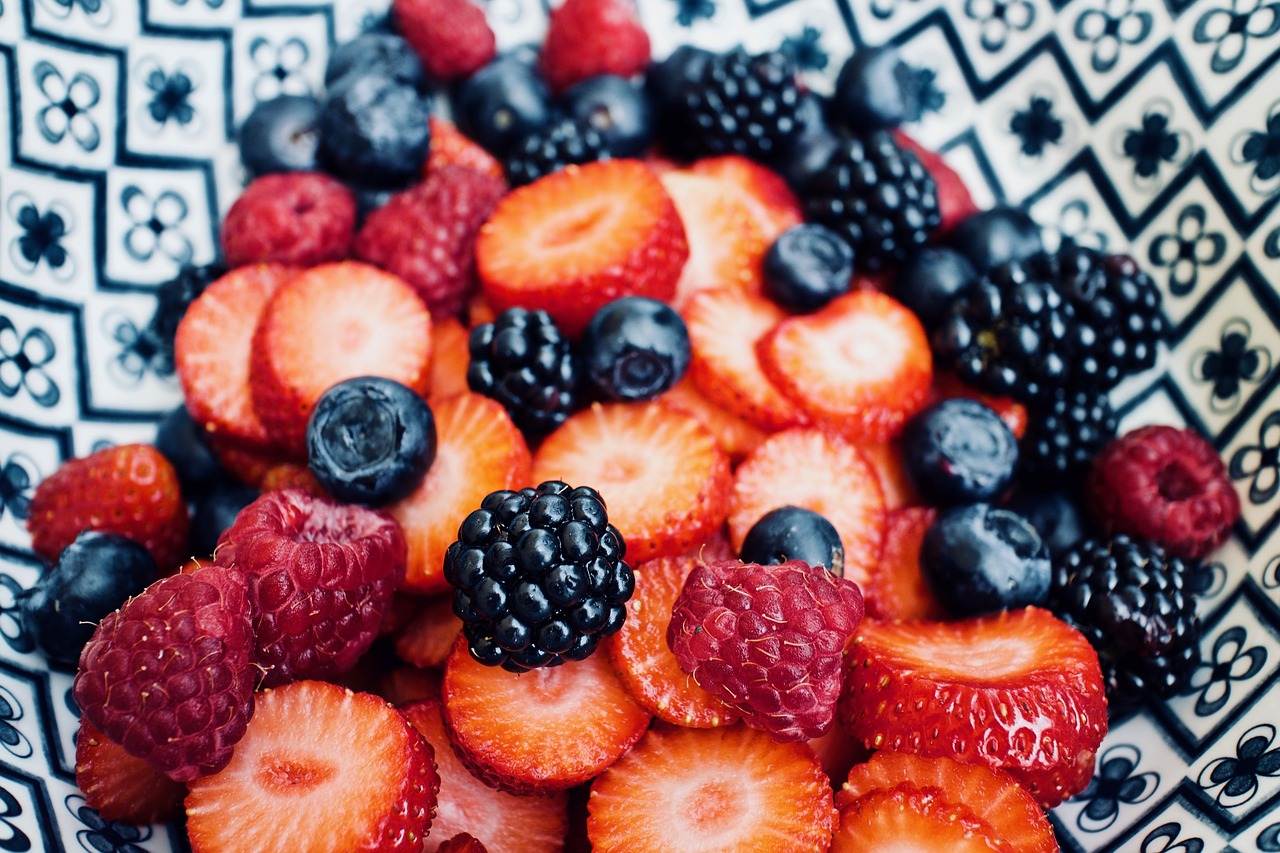
Choosing the Right Type of Food
When it comes to your beloved pets, choosing the right type of food is akin to picking the perfect fuel for a high-performance engine. Just as you wouldn’t fill your sports car with low-grade gasoline, you shouldn’t compromise on your furry friend’s nutrition. Different pets have unique dietary needs based on their species, age, health status, and activity level. So, how do you navigate this maze of options? Let’s break it down!
First off, you need to consider the various types of pet food available on the market. The primary categories include:
- Dry Food (Kibble): This type is convenient, cost-effective, and helps with dental health by reducing plaque buildup.
- Wet Food (Canned): Often more palatable for pets, wet food provides additional moisture, which is great for hydration.
- Raw Diets: Some pet owners opt for raw food diets, believing they mimic a pet's ancestral eating habits. However, this requires careful planning to ensure balanced nutrition.
- Homemade Diets: Cooking for your pet can be rewarding, but it’s essential to consult with a vet or a pet nutritionist to avoid deficiencies.
Now, let’s dive deeper into the pros and cons of dry versus wet food. Dry food is often praised for its convenience and shelf stability, making it easy to store and serve. However, some pets might find it less appealing than wet food, which tends to have a stronger aroma and taste. On the flip side, wet food can be more expensive and less convenient for storage, but it offers a higher moisture content, which is crucial for pets that might not drink enough water.
Ultimately, the choice between dry and wet food may also depend on your pet’s individual preferences and health needs. For instance, older pets or those with dental issues might benefit more from wet food, while active dogs may thrive on high-quality kibble. Mixing both types can also be a great strategy, providing your pet with the best of both worlds!
Another important consideration is whether your pet requires a special diet. Pets with specific health concerns, such as allergies, obesity, or kidney disease, may need tailored nutrition. For example:
| Health Issue | Recommended Diet |
|---|---|
| Allergies | Limited ingredient diets or hypoallergenic formulas |
| Obesity | Weight management formulas with lower calories |
| Kidney Disease | Prescription diets with controlled protein and phosphorus |
When choosing the right type of food, it’s essential to consult with your veterinarian. They can provide personalized recommendations based on your pet’s health history and dietary needs. Think of them as your pet’s nutrition coach, guiding you toward the best choices!
In conclusion, selecting the right type of food for your pet is a decision that requires careful thought and consideration. By understanding your pet’s unique needs and the various food options available, you can ensure that they receive the nutrition necessary for a long, happy, and healthy life. Remember, a well-fed pet is a happy pet!
Q: How often should I feed my pet?
A: It depends on your pet's age, size, and health. Most adult pets do well with two meals a day, while puppies and kittens may require more frequent feedings.
Q: Can I mix different types of pet foods?
A: Yes, mixing dry and wet food can provide a balanced diet, but it’s best to do so gradually to avoid digestive upset.
Q: Are grain-free diets necessary for all pets?
A: Not necessarily. Many pets can digest grains just fine, and some grains can provide beneficial nutrients. Always consult your vet before making significant dietary changes.
Dry vs. Wet Food
When it comes to choosing between dry and wet pet food, the decision can feel a bit overwhelming. Both options have their unique benefits and drawbacks, and understanding these can help you make the best choice for your furry friend. Imagine your pet's food as a balanced diet; just like humans, pets require a mix of nutrients to thrive. So, let's dive into the nitty-gritty of dry versus wet food and what each can offer.
Dry food, often referred to as kibble, is popular among pet owners for a variety of reasons. One of the biggest advantages is its convenience. It's easy to store, has a longer shelf life, and you can leave it out without worrying about spoilage. Plus, the crunchy texture can help reduce plaque and tartar buildup on your pet's teeth, promoting better oral health. However, it’s essential to choose a high-quality dry food that contains adequate moisture content, as some pets may not drink enough water, leading to urinary issues.
On the other hand, wet food often comes in cans or pouches and is typically more palatable for pets. The moisture content in wet food can be highly beneficial, especially for pets that may not drink enough water throughout the day. This can help with hydration, particularly in older pets or those with kidney issues. Wet food is also generally higher in protein and fat, which can be beneficial for pets that need to gain weight or have higher energy needs. However, it can be more expensive and may spoil faster once opened, requiring careful management.
To help you weigh the pros and cons, here’s a quick comparison table:
| Feature | Dry Food | Wet Food |
|---|---|---|
| Convenience | Easy to store and serve | Requires refrigeration after opening |
| Moisture Content | Low moisture | High moisture |
| Dental Health | Helps reduce plaque | Less effective for dental health |
| Cost | Generally more affordable | Typically more expensive |
| Palatability | Less appealing to some pets | More appealing to most pets |
Ultimately, the choice between dry and wet food should be tailored to your pet's specific needs. Some pet owners opt for a combination of both, allowing their pets to enjoy the benefits of each. Think of it as a buffet of flavors and textures that keeps mealtime exciting! Before making a switch, though, it's always wise to consult with your veterinarian, especially if your pet has any underlying health issues or dietary restrictions.
So, whether you decide to go with dry kibble or a delectable wet food, remember that the key is to provide balanced nutrition and keep your pet happy and healthy. After all, our furry companions deserve the best, don’t they?
1. Can I mix dry and wet food?
Yes, many pet owners mix dry and wet food to provide variety and enhance palatability. Just ensure that the total daily intake aligns with your pet's nutritional needs.
2. Is wet food better for older pets?
Wet food can be beneficial for older pets due to its higher moisture content, which helps with hydration. However, consult your vet for personalized dietary recommendations.
3. How do I transition my pet to a new food?
To transition your pet to a new food, mix a small amount of the new food with their current food, gradually increasing the new food over a week or so. This helps prevent digestive upset.
4. How much should I feed my pet?
Feeding amounts depend on your pet's size, age, and activity level. Always refer to the feeding guidelines on the pet food package and consult your vet for tailored advice.
Special Diets
When it comes to our beloved pets, their diet is not just about filling their bowls; it's about ensuring they lead a happy and healthy life. Special diets are often essential for pets with specific health concerns, allergies, or unique nutritional needs. For instance, pets suffering from conditions like diabetes, kidney disease, or obesity may require tailored nutrition to manage their health effectively. It's vital to recognize that what works for one pet might not be suitable for another, and that's where understanding special diets comes into play.
First and foremost, consulting your veterinarian is crucial. They can help determine if your pet requires a special diet based on their health status. Here are some common types of special diets that you might encounter:
- Prescription Diets: These are formulated specifically for pets with medical conditions and are often only available through veterinary clinics.
- Grain-Free Diets: Ideal for pets with grain allergies, these diets exclude common grains like wheat and corn, focusing instead on meat and vegetables.
- Low-Protein Diets: Recommended for pets with kidney issues, these diets limit protein intake to reduce the workload on the kidneys.
- Weight Management Diets: Designed to help overweight pets lose weight safely, these diets are lower in calories and higher in fiber.
Each of these diets serves a specific purpose, and the right choice can make a significant difference in your pet's quality of life. For example, a weight management diet can help your furry friend shed those extra pounds, while a low-protein diet can be crucial in managing kidney health. It's like putting together a puzzle; every piece matters, and the right fit can lead to a healthier, happier pet.
Moreover, transitioning to a special diet should be done gradually. Sudden changes in diet can upset your pet's stomach and lead to digestive issues. A good rule of thumb is to mix a small amount of the new food with the old food, gradually increasing the new food's proportion over a week. This slow transition helps your pet adjust and reduces the risk of gastrointestinal upset.
In conclusion, special diets are not just a trend; they are a necessary consideration for many pets. By understanding your pet's unique needs and working closely with your veterinarian, you can choose the best diet that supports their health and well-being. Remember, a well-fed pet is a happy pet!
Q: How do I know if my pet needs a special diet?
A: If your pet is showing symptoms like excessive weight gain, vomiting, diarrhea, or lethargy, it’s best to consult your veterinarian. They can help determine if a special diet is necessary.
Q: Can I switch my pet to a special diet on my own?
A: While you can research dietary options, it's always recommended to consult with your veterinarian before making significant changes to your pet's diet.
Q: Are special diets more expensive than regular pet food?
A: Special diets can be more costly, especially prescription diets. However, investing in your pet's health can save you money in the long run by reducing vet bills related to health issues.
Q: How long does it take for a special diet to show results?
A: The timeframe can vary based on the diet and the pet's condition. Some changes may be noticeable within weeks, while others may take months. Regular check-ups with your vet can help track progress.
Frequently Asked Questions
- What should I look for on pet food labels?
When reading pet food labels, focus on the ingredients list, which should ideally start with a high-quality source of protein, like whole meat. Look for specific ingredients rather than vague terms like "meat by-products." Additionally, check for nutritional adequacy statements to ensure the food meets your pet's dietary needs.
- Are meat by-products harmful for my pet?
Not necessarily! While some meat by-products can be lower quality, others can provide essential nutrients. It's important to evaluate the overall quality of the pet food and prioritize products that clearly state their protein sources. Always aim for foods that specify whole meats as the primary ingredient.
- Is grain-free food better for my pet?
Grain-free diets can be beneficial for pets with specific allergies, but not all grains are bad. Some grains, like brown rice or oats, can provide valuable nutrients and fiber. It's crucial to consult with your veterinarian to determine the best diet for your pet's individual needs.
- Should I choose dry or wet food for my pet?
Both dry and wet food have their advantages! Dry food is often more convenient and can help with dental health, while wet food provides extra moisture, which is great for hydration. Consider your pet's preferences, health needs, and lifestyle when making your choice.
- When should I consider a special diet for my pet?
If your pet has health issues like obesity, allergies, or digestive problems, a special diet may be necessary. Always consult your veterinarian before making significant changes to your pet's diet, as they can recommend the best options tailored to your pet's specific health conditions.

